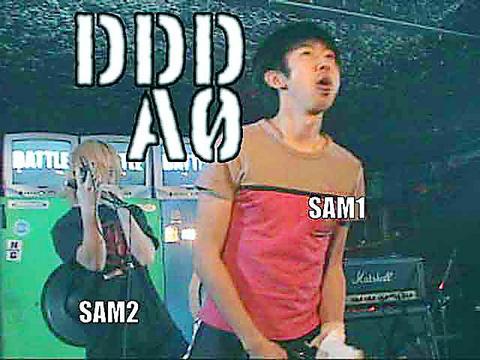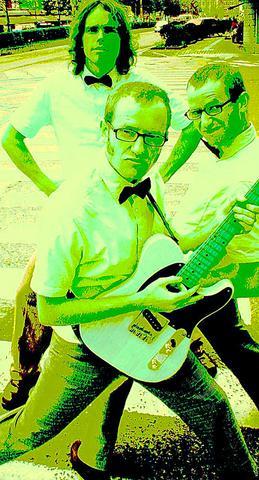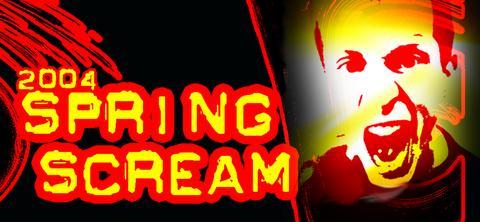The 10th Spring Scream could be one for the purists, as founders Jimi Moe and Wade Davis stage a 10-day festival that aims to recover the spirit of the event's early years. It will also build up to what's become known as Spring Scream weekend, which has sprouted into a massive jamboree of other art festivals, raves on the beach, and hotel or club parties in and around Kenting.
The festival started today at its usual location, nestled in a few of Kenting National Park's fields near Liou Fu San Juang, and will have music every day until it kicks into high gear next weekend.
"Some people confuse Spring Scream with all the other stuff [dance music events] that goes on. Nobody's gone out to call their event Spring Scream, though there've been variations of it. But the name's stuck, I think, because it's a catchy phrase and looks good on a headline. Some people who've never been to Spring Scream think they've been because they went to a party on the beach at the same time," Davis said.

PHOTO COURTESY OF SPRING SCREAM
Moe and Davis started the festival in 1995 when a few musicians and artists set up the first arts-music festival at Magic Studios, near the Kenting National Park entrance. After being held in different places, the weekend settled six years ago on its current site and grew over the years to its present size: 10 days, three stages, 205 bands scheduled (125 bands on standby), an art and film festival, stalls, workshops, and more.
Separate dance music events got in on the act four years ago and the crowds have multiplied, along with the media presence, which has painted the whole scene in terms of general bacchanalian abandon.
As a result of this not entirely undeserved image (and a drowning death two years ago), there has been increased police attention. Officers swooped on five out of seven parties on one night last year, citing suspicion of drugs on the "premises" as the reason for the raids.

PHOTO COURTESY OF SPRING SCREAM
ISOLATION POLICY
Spring Scream has kept itself largely isolated from this madness by virtue of its longstanding reliability, being further away from the town center, closing down at 12pm, and because of the relationships it has cultivated with the authorities and local residents. It has also strongly disassociated itself from the other parties.

PHOTO COURTESY OF SPRING SCREAM
"It's two different crowds, maybe 3 percent to 8 percent of the crowd that comes down for the dancing will come to Scream, but I reckon the figures are more like 6,000 to 10,000 of them, and 2,000 rockers. Their influence is much larger than ours, they're a different demographic to us. The more people I talk to, the more I realize that we don't have the same crowds," Moe said.
"For the last four years I've just hated the dance music thing, I just despised it, putting a needle on plastic and calling it music. I guess I always appreciated scratch. Now I'm impressed with some electronica ... It's come a long way and that's why we've started putting it on."
As for the drugs that have plagued the party weekend, Davis said they weren't a problem for Spring Scream. "We've never been raided. The first year at the beach there was a noise complaint, so we moved it and took it off the beach and that was it. We've never been raided, there have been no arrests or anything in six years."

INEVITABLE CHANGE
Both Moe and Davis said, in separate telephone interviews, that they recognized the Spring Scream weekend has changed and accept they will have to adapt too. They are considering sponsorship, but are worried about their principles.
"Change or not has been the eternal question. We might be in the minority, everyone else is backed by the technology and the media, but we're keepin' it live. Even so, we know change is inevitable," Moe said.
The only problem is everyone has a different idea of how Spring Scream should meet the challenge of the next 10 years. Moe and Davis want to please everyone, but realize they have to blow off some of their audience to keep reaching new audiences. Or blow off new audiences, to keep the loyal Spring Screamers.
"The more people that come, the more bi-polar they are. There are the traditionalists who want it to be how it was five or 10 years ago and complain, `Oh, it's not so intimate.' And then there are the others saying, `We want it like Saturday night, every night.' You can't win," Moe said.
"We started as an arts-music festival and I think we've stayed true to that. We've kept prices down and avoided sponsorship, we've been into non-branding. Maybe we need to change."
As far as the blueprint for Spring Scream is concerned -- live music, field, no DJs, finish at 12 -- it may have to change as thousands troop to hear one DJ and hundreds turn up for 100 bands. One idea is international headliners, another is getting in bed with a sponsor.
"People have a good time, so we don't want to change it, but if we do it will need sponsors, international bands. Maybe that is a direction we have ignored and it is our own fault. We get so caught up in making ends meet, maybe we've not been so open to things as we should have been," Davis said.
TAKEN TO BED
Talking about how Glastonbury in the UK evolved into a festival that included all genres of music, Moe said things could be different next year, with a new format. "Maybe there will be a `Kentingbury' next year. Nah. This year we've got 10 days of music with three stages, next year it could be three days and 10 stages. We wanna push the envelope. No matter what you do, you have to second-guess yourself. When we realized we had committed ourselves to 10 days and couldn't turn back we thought, whatever, we can turn it round next year."
Looking forward to another 10 years of Spring Scream, Davis said, "We started with the idea of bands and making original music, here, in Asia. That's what we decided to concentrate on and support, and from that perspective it has worked. At this point, it all works, dance music doesn't need our support. The idea is that you have to pick your tree out of the forest. And that's what we've done. We could take it toward Fuji Rock [Japan]."
This year, however, it's going to be a back-to-to-their-roots Spring Scream, with 10 days of fun in the sun. "What we do say is if it's not fun then we won't be doing it. ... But I do get a kick from it, especially when someone has a story to tell. And they always do," Moe said.
"There was this full-on rock star last week and I told him what I did and he said, `Kenting? No way. I was there, like, seven years ago, we had sarongs and climbed on this hill and, like, flashed everyone.' Everyone who's been has a story, even if some of them nowadays are about the traffic and the noise. It's usually about the first time they saw a band, or met their wife. A lot of stories about Christmas babies, too."

On April 26, The Lancet published a letter from two doctors at Taichung-based China Medical University Hospital (CMUH) warning that “Taiwan’s Health Care System is on the Brink of Collapse.” The authors said that “Years of policy inaction and mismanagement of resources have led to the National Health Insurance system operating under unsustainable conditions.” The pushback was immediate. Errors in the paper were quickly identified and publicized, to discredit the authors (the hospital apologized). CNA reported that CMUH said the letter described Taiwan in 2021 as having 62 nurses per 10,000 people, when the correct number was 78 nurses per 10,000

As we live longer, our risk of cognitive impairment is increasing. How can we delay the onset of symptoms? Do we have to give up every indulgence or can small changes make a difference? We asked neurologists for tips on how to keep our brains healthy for life. TAKE CARE OF YOUR HEALTH “All of the sensible things that apply to bodily health apply to brain health,” says Suzanne O’Sullivan, a consultant in neurology at the National Hospital for Neurology and Neurosurgery in London, and the author of The Age of Diagnosis. “When you’re 20, you can get away with absolute

May 5 to May 11 What started out as friction between Taiwanese students at Taichung First High School and a Japanese head cook escalated dramatically over the first two weeks of May 1927. It began on April 30 when the cook’s wife knew that lotus starch used in that night’s dinner had rat feces in it, but failed to inform staff until the meal was already prepared. The students believed that her silence was intentional, and filed a complaint. The school’s Japanese administrators sided with the cook’s family, dismissing the students as troublemakers and clamping down on their freedoms — with

As Donald Trump’s executive order in March led to the shuttering of Voice of America (VOA) — the global broadcaster whose roots date back to the fight against Nazi propaganda — he quickly attracted support from figures not used to aligning themselves with any US administration. Trump had ordered the US Agency for Global Media, the federal agency that funds VOA and other groups promoting independent journalism overseas, to be “eliminated to the maximum extent consistent with applicable law.” The decision suddenly halted programming in 49 languages to more than 425 million people. In Moscow, Margarita Simonyan, the hardline editor-in-chief of the